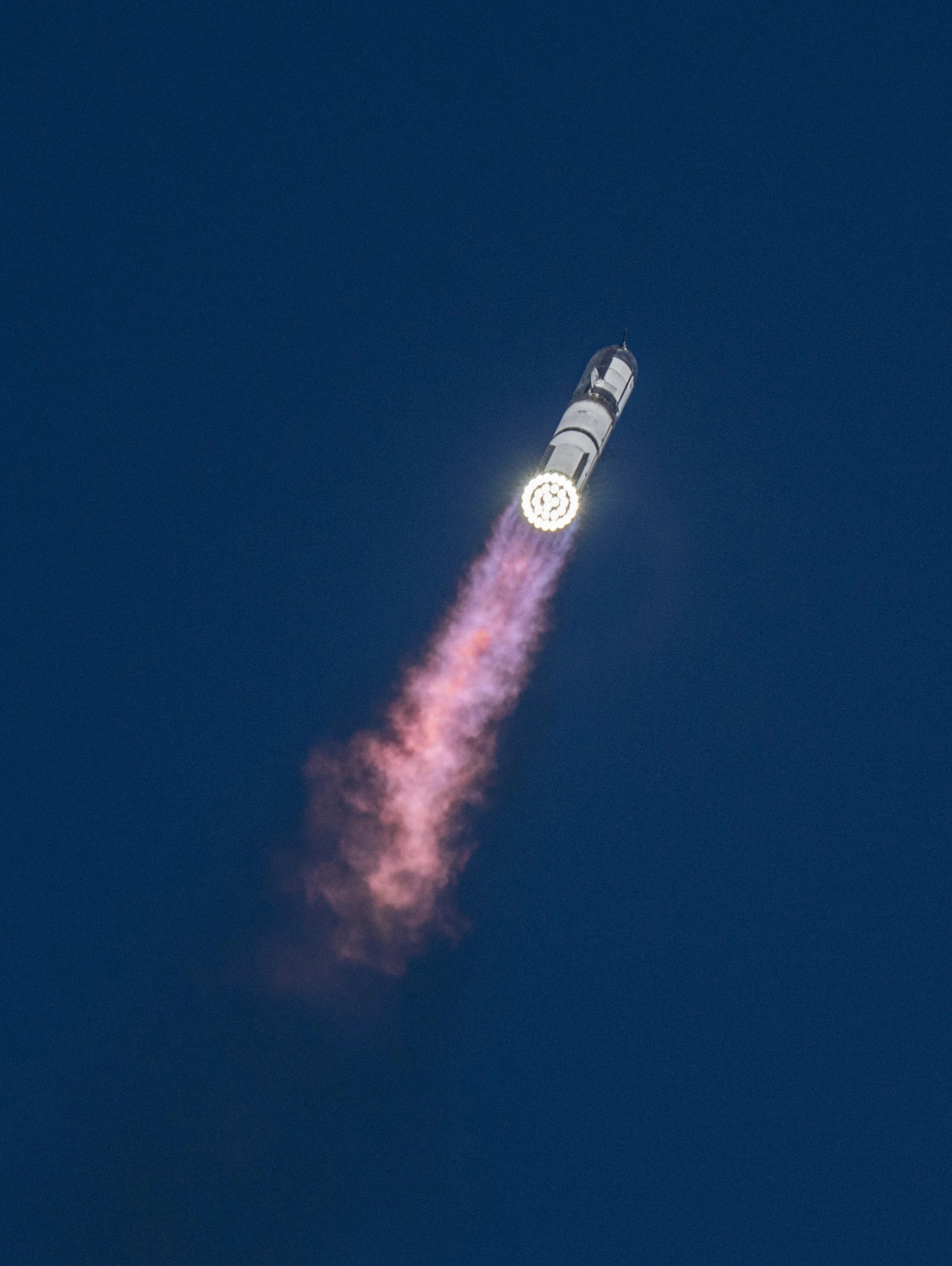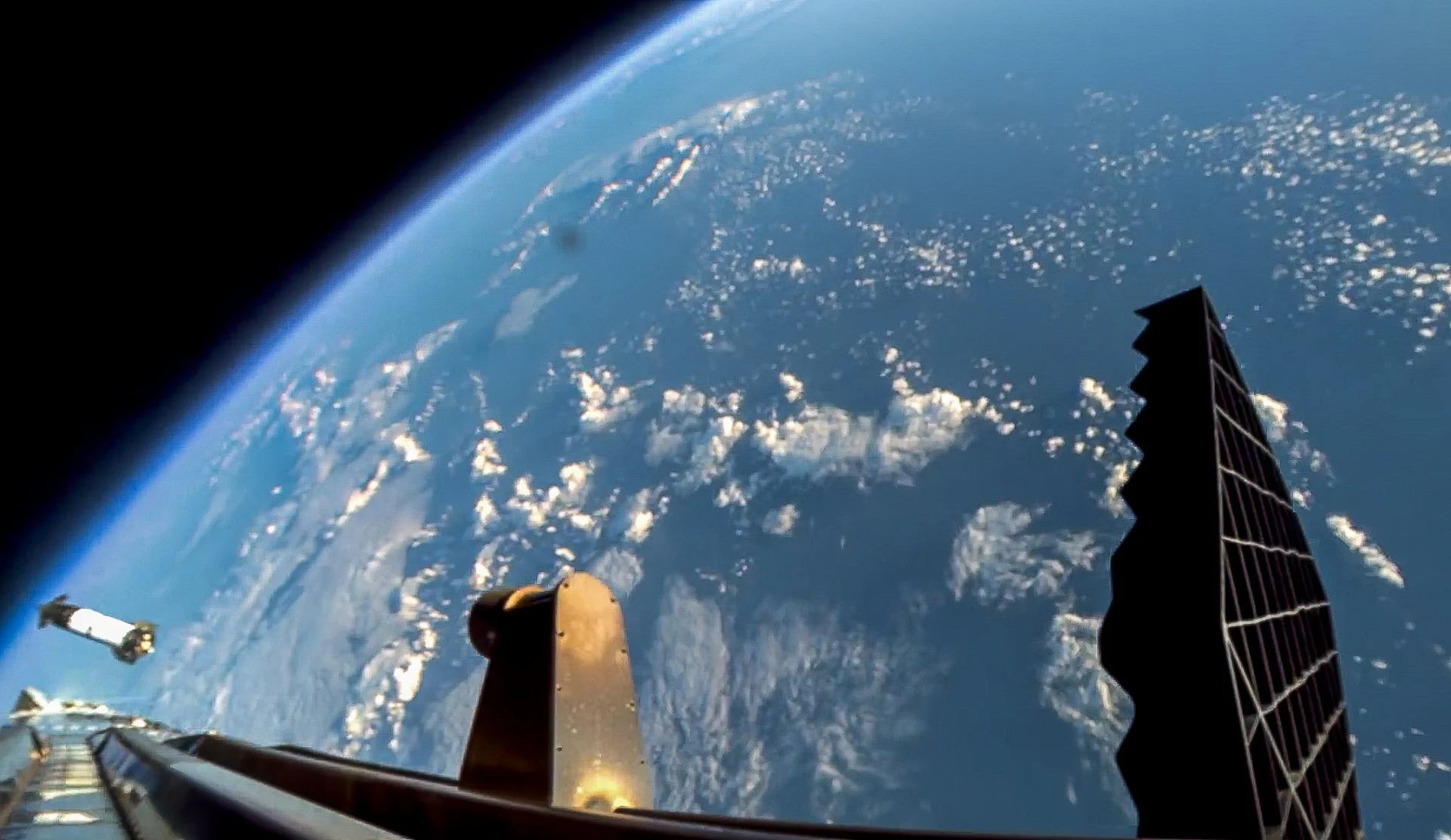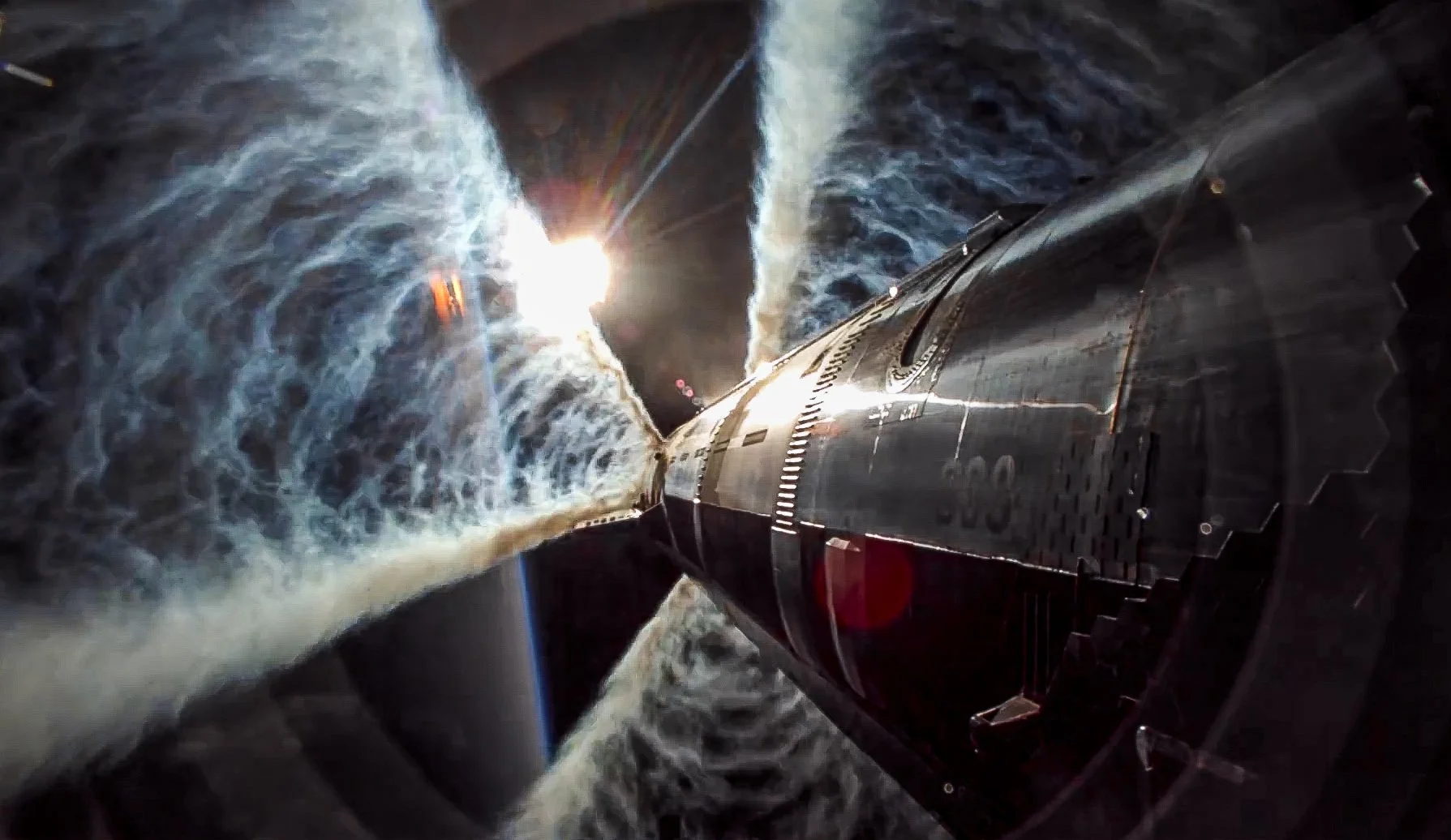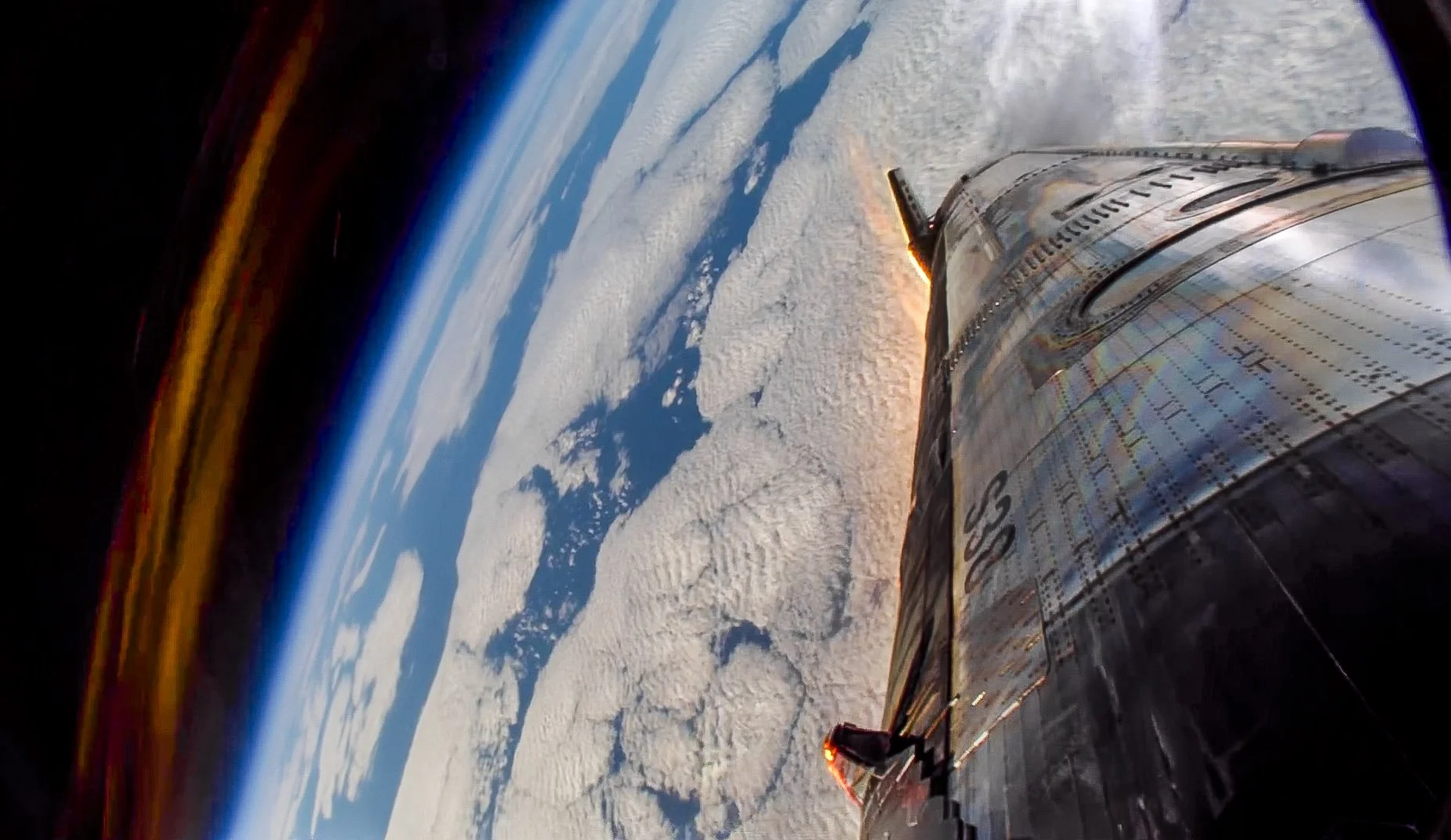The end of an era - Flight 11 was a success
Flight 11 gave a proper sendoff to the era of Block 2 vehicles and Pad 1, with both Booster 15-2 and Ship 38 reaching their planned objectives in a nearly flawless flight. Here, we’re going to dive deep into what happened during this flight, what objectives were reached and how, what new information we gained from the stream, and especially what this flight means for the program, with a look to the future.
Flight 11
From launch to SECO
The past and the present looking at each other. Credit: Nathan Moeller
As we got closer to the launch, the final operations were conducted: at T-3m20s the Ship propellant load was completed, with 97.2% of CH4 and 98.6% of LOX loaded onto the vehicle; about 30 seconds later, the Booster propellant load was wrapped up as well, with 96.5-97.7% of CH4 and 93.7-94.9% of LOX loaded in the tanks.
Following propellant closeout, the tower and propellant feed system lines were cleared as leftover propellant was pushed back into the tanks, in an operation called “pushback.”
SpaceX later conducted last-minute checks and tests, like arming the Flight Termination System and steering the engines in a TVC check: this particular check was conducted at T-1m40s, where the inner 13 engines gimbaled by turning, opening up like flower petals, then closing back in, opening again, turning in a direction, and then turning back to the original point, and finally closing in the launch position. This check was conducted once again after T-40s.
Starship went through that T-40s hold with all the board GO for launch, including the final call by the Flight Director… finally, the Detonation Suppression System (DSS) was activated to prevent explosions, and the water deluge followed immediately after for one final launch.
Launch occurred flawlessly, with all 33 engines igniting on the Booster, and the full stack quickly rising into the sky. The ascent occurred without any issues, with the full stack clearing Max-Q, the moment of peak mechanical stress, and going towards separation: about 2 minutes into the flight, the full stack began the roll maneuver, a new maneuver introduced on Flight 9, which allows Starship to be aligned with the launch site so that the Booster can flip back in that direction after separation; as a reminder, SpaceX came up with the idea of using steel plates to cover some of the holes on the HSR, enabling the Ship’s plume to push the Booster away after stage separation. However, it needs to be correctly oriented, and that's why the roll is conducted; starting with Block 3 there won’t be such plates, but the Booster’s direction after the separation will be controlled by fine-tuning the Ship’s engine ignition.
Starship on ascent. Credit: SpaceX
About 2m40s into the flight, the 2 stages separated: Booster 15 started by shutting down all but 3 of its engines, and a few seconds later Ship 38 ignited all its 6 Raptors, allowing the 2 stages to separate. Ship 38 kept ascending onwards, while Booster 15 was pushed away and relit 12 out of the 13 planned engines for the boostback burn, although nobody was worried about the missing engine given that the big number of Raptors used for each burn on Starship allows reliability and redundancy in cases like this. After a roughly 40-s-long burn, Booster 15 shut down its engines and separated the hot staging ring for one final time, as both began to descend.
Both vehicles following separation. Credit: SpaceX
Immediately after the boostback burn shutdown, Booster 15 began the LOX dump, where most, or all, of the LOX in the main tank was vented out since it won’t be needed anymore (to land, it uses a designated landing tank).
During its descent, conducted at the same angle of attack (AoA) as Booster 16, the Booster reached a peak velocity of 3931 km/h at 27 km, using its body drag to slow itself down ahead of landing. As it neared the landing burn and passed through thicker parts of the atmosphere, at T+6m5s, it began to sway around under a partial loss of control, which the grid fins counteracted: this sway was also observed during Flight 10’s descent, and it had caused the failure of a grid fin, although this Booster seemed to have passed it flawlessly.
At 2.7 km and T+6m7s, Booster 15 ignited all 13 engines for the landing burn, switching to the planned 5 engines 6 seconds later, at an altitude of just 1.0 km. With these, it kept slowing down and descending until reaching 0.3 km 8 seconds later, where it cut down to the 3 center engines and completed the 19-s burn, ending with a plummet in the ocean, which led to a voluntary explosion.
This new engine configuration gave SpaceX amazing data on the 5-engine phase of the burn, which will be used by the Block 3 configuration to fine-tune the final path of the booster and give more reliability in the case of an engine not working. Also, as incredible as it may seem, this configuration is aimed at lowering propellant consumption while still increasing precision and reliability.
Booster 15 during its landing burn. Credit: SpaceX
In the meantime, Ship 38 kept conducting its ascent burn for a couple of minutes; then, it cut off its RVas at T+8m46s, followed by SECO at T+9m1s. Some of the things we could already see were that the bottom of the aft flaps had once again been heated to discoloration by the Booster during boostback burn (or hot staging), and half or near half the tiles pinned to the leeward side of the flaps to test attachment methods had fallen off during ascent. Neither one was a big deal for the flight, but it gave useful data for future tests.
Ship 38 cutting off its engines. Credit: SpaceX
Coast phase
Several experiments were planned for the Ship during the coast phase: payload deployment and engine relight.
Immediately after engine shutdown, Ship 38 started dumping all its leftover propellants from the main tanks, since it wouldn’t need them anymore (every burn past SECO uses the header tanks on the tip of the nosecone), from lines on the bottom of the ship's skirt.
After this operation was completed, the Ship prepared for payload deployment: first up, it used its RCS (Reaction Control System) thrusters to point itself towards north, with the leeward side (the one without the heat shield) pointed towards east. Then, it started to open its payload bay door: to open the door, it first pushed itself inward, letting all the pressure out, and then it was raised, giving a clear space for satellite deployment; this whole sequence took just 25 seconds at T+17m, which was slightly quicker than last time.
Views from the inside of the payload bay. Credit: SpaceX
After the door was opened, payload deployment finally started: the 8 Starlink V3 simulators (also named simlinks) resemble the mass distribution and shape of the future Starlink V3. Therefore, they each have a 1.9-ton mass, for a total payload mass of roughly 15 tons.
These satellites are stacked on what’s called the PEZ dispenser, which works as the name intends: the 2 columns of satellites are stacked on a rail system, and when it activates, the rails move position and align one couple of simlinks at a time in front of that door. Then, a sort of “safety pin” is removed, and the rest of the satellites go slightly up, leaving the to-be-deployed couple independent; that’s when a signal is sent, and 2 conveyor belts on the sides accompany the simlinks along them, up to immediately before going out the door. That’s when the satellite (single) separates from the system and goes out of the door on its own; at this point, the second satellite of the couple is pulled back inside by the same conveyor system and then pushed out in the same way as the first one. Finally, the process concludes with the next couple of satellites taking position before starting all over again.
Each couple of satellites takes about a minute to separate from the main stack and exit, in addition to the time required to align the next couple of satellites; this is why the payload deployment sequence lasted 5.5 minutes. However, this is an improvement from the last time it was done; some of the changes included improvements to the PEZ dispenser, the rails, and even the simulators themselves, which gave a more stable deployment; this is important, since last time, some of the simlinks bumped into the door on their way out, risking to remaining stuck inside. Another improvement, this time to operations instead of actual hardware, is the change during the reset, making the second satellite deploy from halfway down the rail, instead of from its start. This way, deployment time is reduced. It’s really important to reduce the deployment time and improve it, since Starship will start operational missions of Starlink V3 in 2026: there, it will take up to 64 real, expensive, important communication satellites to orbit, where a single launch of them will match the capacity given by 20 Falcon 9 launches. So, to make a comparison, it would take Starship about 4-6 launches to match the communication capacity that Falcon 9 reached in last year’s Starlink launches (roughly 90). That is crazy, but it’s real, as the next era of communication is here.
Following the completion of payload deployment, the door closed at T+26m, and the Ship continued its coast phase nominally. In the meanwhile, it turned back to pointing east ahead of engine relight: this test was a prograde burn (meaning it was a burn in the direction where the Ship was already going, therefore adding velocity; we could see it as pedaling on a bike instead of pulling the brakes), and it was supposed to test, once again, the performance of Block 2 for a burn mimicking a deorbit one; to make it as look-alike as possible, the engine relight uses propellant fed from the header tanks.
The burn occurred at T+37m54s, lasted 4 seconds, and added a mere 20 m/s of delta-V: this burn was conducted by a sea-level engine, specifically E3, which also conducted a small TVC test during the burn.
Once concluded, it marked the end of the coast phase experiments for the Ship, which would now get ready for reentry.
Ship 38 reigniting an engine in space. Credit: SpaceX
At T+39m, below 135 km, a thin and barely visible layer of plasma started forming on the heatshield of Ship 38 as it began to pitch up for reentry, almost pointing to its zenith.
As a reminder, there were a lot of experiments riding on this one heatshield, or rather, there weren’t: SpaceX had in fact intentionally removed 70+ tiles from various areas across the Ship; most were removed in batches of 4 along the length of the heatshield and the flaps, but some were removed randomly from the tip of the nosecone and other key areas. This time, there were NO metallic or actively cooled tiles, as SpaceX’s main focus was to see whether the Ship could endure the reentry conditions even with this many tiles off, which set this up to be an interesting reentry.
As Ship 38 kept reentering, passing below 120 km at T+42m and below the Karman Line at T+45m, the thin layer grew to a thick cover of the usual reddish/pinkish plasma we see during reentry. At T+48m, when the Ship was at 85 km in altitude, plasma was starting to build up in several protruding hotspots, like the aft flap’s shoulder and the catch points; this led to overheating, and some pieces, albeit small, flew off the vehicle; however, this was not serious (for now).
About 2 minutes later, as the Ship kept slowly descending into the atmosphere, flaps gained control of the vehicle and started moving, demonstrating this steering ability during reentry and allowing for small changes in the orientation, although these changes had to be small due to the great thermal and structural forces the Ship was subjected to, which also led to yellow flashes near the aft flaps, which ended up being the plasma making contact with some materials on the vehicle (possibly the stainless steel itself), causing significant chunks of it to come off.
Ship 38 reentering. Credit: SpaceX
At T+51m50s, the operator on callout announced that the Ship was about to reach the peak heating phase of entry, which is the point of peak thermal stress; this was noticeable by the yellow flashes on the aft of the vehicle, along with bright yellow and blue flashes coming from the aft flaps. Once again, these colors indicate that the plasma is touching something that it shouldn’t in normal conditions, but being this a test, it was normal and expected.
As it kept descending in the atmosphere, Ship 38 changed its inclination from pointing zenith to pointing about 45° above the horizon and also turned slightly sideways in preparation for the big show… the banking maneuver: at T+57m30s, Ship 38 conducted a roughly 30s-long maneuver that took it pointing halfway between North and East! So, imagine having a clock: the Ship usually reenters pointed towards 12, so up; from this point on, it was reentering towards 9, on the side! This maneuver, which happened near the peak heating phase, caused more serious damage on the aft flaps and heatshield, with significant chunks coming off.
Ship 38 reentering during the banking maneuver. Credit: SpaceX
As the maneuver was completed, external temperatures began to come down, and a few seconds later the ship passed through entry Max-Q, at an altitude of 52 km and a speed of 11.000 km/h. About one and a half minutes later, as the mission clock hit 1 hour, the plasma vanished, while some hot spots were still being observed. Following this milestone, 45 km up into the sky, the Ship used its flaps to make an almost 180° turn to point south, and it also put itself in a horizontal position, beginning the bellyflop phase, where the Ship uses the drag caused by its body to slow itself down ahead of landing; this is also the phase when the flaps have the most control of the vehicle and aim it to the target splashdown zone.
At T+1h4m47s, the 3 sea-level Raptors began chilling down ahead of ignition, and a few seconds later the Ship conducted a final aggressive 90° turn, from southwest to southeast, as part of the new descent algorithms SpaceX was talking about.
All these new maneuvers, including the banking maneuver and the turns, are meant to mimic the real-life scenario of a future Ship coming back to the launch site to be caught, where it will initially target the coast off the Gulf of Mexico before turning back and flying over Starbase for a catch; as a reminder, this could happen as soon as Flight 13, likely in the first half of next year, but timelines will change.
And finally, what may be the most interesting part, the landing burn: the first engine lit at T+1h5m54s, followed less than a second later by the remaining ones, as the Ship used its flaps to move from a horizontal to a vertical position at an altitude of about 1 km. The terminal velocity went from 336 to 339 km/h before coming down, as all 3 Raptors slowed it down exactly like they would during a catch; 12 seconds into the landing burn at 77 km/h and less than 200 meters in altitude, it shut down 1 engine and remained with the other 2 running for a few more seconds until T+1h6m12s, when it softly splashed down at 15 km/h, marking the end of a fully successful mission! Following the engine shutdown, the Ship overturned and collided with the water at a speed of 45 km/h, resulting in an immediate explosion.
Ship 38 landing. Credit: SpaceX
Pre-launch stream and Block 3 updates
After a small, 8-minute delay for the launch, the stream started at T-28m, hosted by Amanda Lee, a build reliability engineer, and Jake Berkowitz, a lead propulsion engineer. Throughout the stream, we also got a glimpse of Elon Musk making a surprise appearance, and then the commentators were joined by Dan Hout.
During the stream we were gifted with several new pieces of information about Starship, so let’s dive into it:
Block 3
Starship Block 3 render. Credit: SpaceX
As the commentators explained, the next generation of vehicles will have a lot of changes that will make the rocket better, more powerful, and more reliable.
Starting with the Booster, some of the more prominent changes will be the switch from 4 to 3 grid fins, which will have a different shape, be stronger, and be located 90° from each other, with lift points integrated into it, serving as catch points as well. It will also feature an integrated hot staging ring at the top, which has been revealed to have a non-structural layer of steel plates on its top to protect it from the heat of hot staging. Overall, these changes will make the booster a lot more efficient and a lot better.
Going to the Ship, Dan Hout stated it has more internal changes than external, and we still don’t know what those will be. However, some external and known changes are the inclusion of catch and lift points together, like the Booster, a redesigned SQD, and the addition of docking ports for future docking and propellant transfer. They also said the Ship will have amazing upgrades for energy storage and avionics, allowing for longer missions as it gets into the era of operational and groundbreaking flights.
Additionally, SpaceX showed videos of the test tanks at the Massey’s test site, B18.1 resembling a Booster aft section and B18.3 resembling a Booster fwd section, including the integrated hot staging ring. They showed B18.3 undergoing cryogenic testing and said B18.1 was subjected to 131 MN of force in a structural test, which is an incredible amount!
Now, SpaceX is going to put all of its focus on Block 3: starting on the same day as Flight 11 and continuing in the following days, many sections rolled out of the Starfactory:
All the barrel sections for Booster 18’s methane tank and forward sections rolled into Megabay 1, including the integrated hot staging ring! Booster 18 stacking has been underway since mid-May, with the LOX tank and bottom section built first; now it’s time to build the upper section and join them together, making the first Block 3 vehicle built.
Ship 39 has also seen the start of stacking, with the nosecone and payload bay sections rolling into MB2 and stacked together. This was a long-awaited moment, with the nosecone being visible through the Starfactory glass for months, and SpaceX couldn’t have chosen a better moment to start.
So… what about timelines? Well, don’t expect turnaround times of 1-2 months like we’ve seen so far, since the vehicles for this flight are the first of a new generation (meaning issues and delays will arise), and they’re also really early in their developmental life.
If all goes well, we could be seeing the Booster complete stacking in November, with cryogenic tests soon afterwards; the same would go for the Ship, sometime later than the Booster.
They will then need to have Raptor 3 installed and head out for their respective static fire testing campaigns.
That said, there is no chance that Flight 12 will happen this year, but rather early next year. Our hope is that it will happen sometime in February, but given the early stage of the vehicles and the unknown developmental challenges, the schedule will change.
Raptor 3
Raptor 3 firing. Credit: SpaceX
Of course, the major change for Block 3 will be the introduction of the new generation of engine, named Raptor 3. This engine is the current pinnacle of rocketry, able to allegedly generate 2.64 MN of thrust per engine while being much lighter and less susceptible to failure. One of the major causes of its light mass is the elimination of the engine shielding, which will not be needed anymore, making us able to completely see the engine turbomachinery during lifts, launches, and landings.
During the stream, we were blessed with the first video of a startup of a sea-level Raptor 3, as well as a video demonstration of its TVC capabilities (Thrust Vector Control, the ability to steer the engine to redirect the plume and therefore the thrust without changing the vehicle’s orientation), which greatly surpass the speed and precision of Raptor 2.
We also got the first-ever video of a vacuum-optimized version of Raptor 3 firing!
The firings are all happening at the McGregor facility, where all the engine stands dedicated to Raptor are testing this version, with multiple tests a day. Thanks to confirmation during the stream, we now know that the first Flight 12 engines are in production and should begin testing soon, and they may have already been tested (we saw similar testing of engines R37-R39 in the days following the flight). This means we may see these engines integrated on a vehicle by the end of the year.
Pad 1
What will happen to our beloved Pad 1? Don’t worry, because it will not go away… sort of: SpaceX will maintain the current tower and pad location, but it will completely change the design and make it like Pad 2. This includes reinforcements to the tower, a redesigned SQD arm, redesigned chopsticks (which may be the current ones, just cut shorter and fixed), a new OLM (which is still to be built), the excavation of a flame trench, upgrades to the tank farm, and much more. All these changes translate to a lot of demolition and replacement, not to mention construction, so the timelines are variable: it is likely that Pad 1 won’t be able to support a launch before late 2026, although it is possible this may slip to early 2027. This may seem like a lot of time, but with Pad 2 coming operational early next year and the LC-39A pad at the Kennedy Space Center coming online next year as well, we may have 3 active launch pads by the same time next year, or anyway, really close.
Thanks for reading so far; we hope you had an amazing experience, and please consider sharing this article with family and friends and keeping yourself updated on our website, with more articles and projects to come.
References
FULL Starship Flight 11 broadcast re-upload
SpaceX - Starship's Eleventh Flight Test











